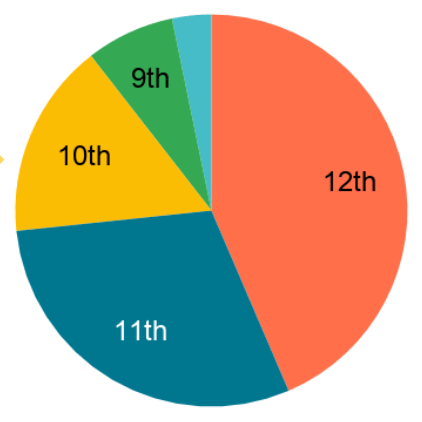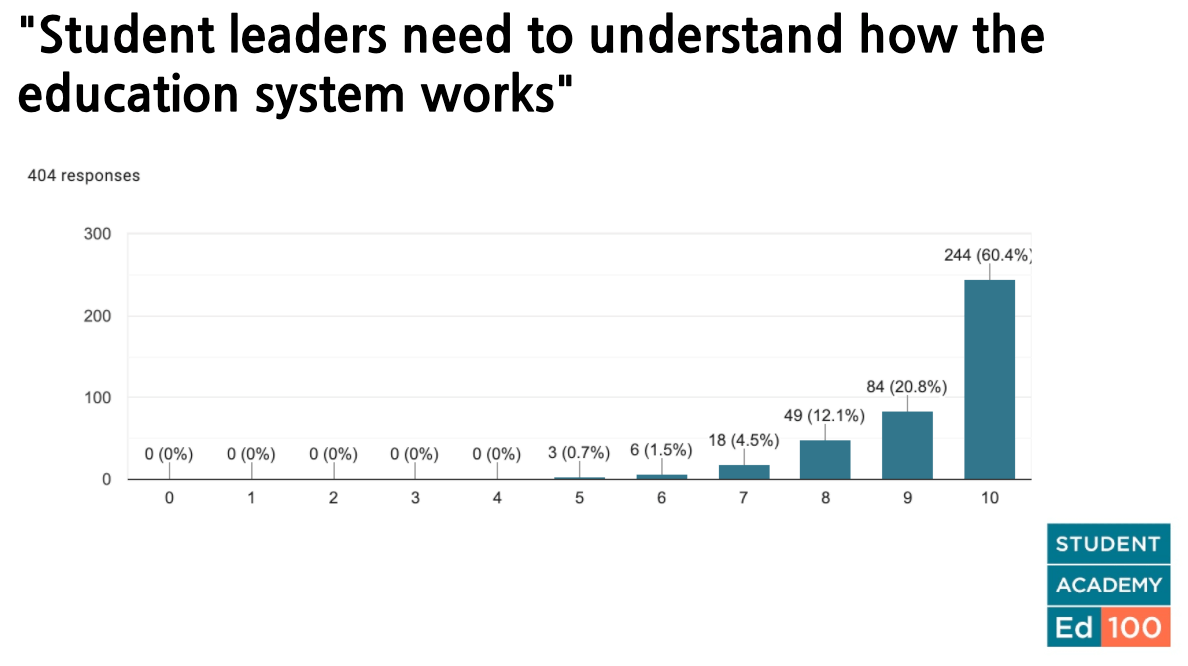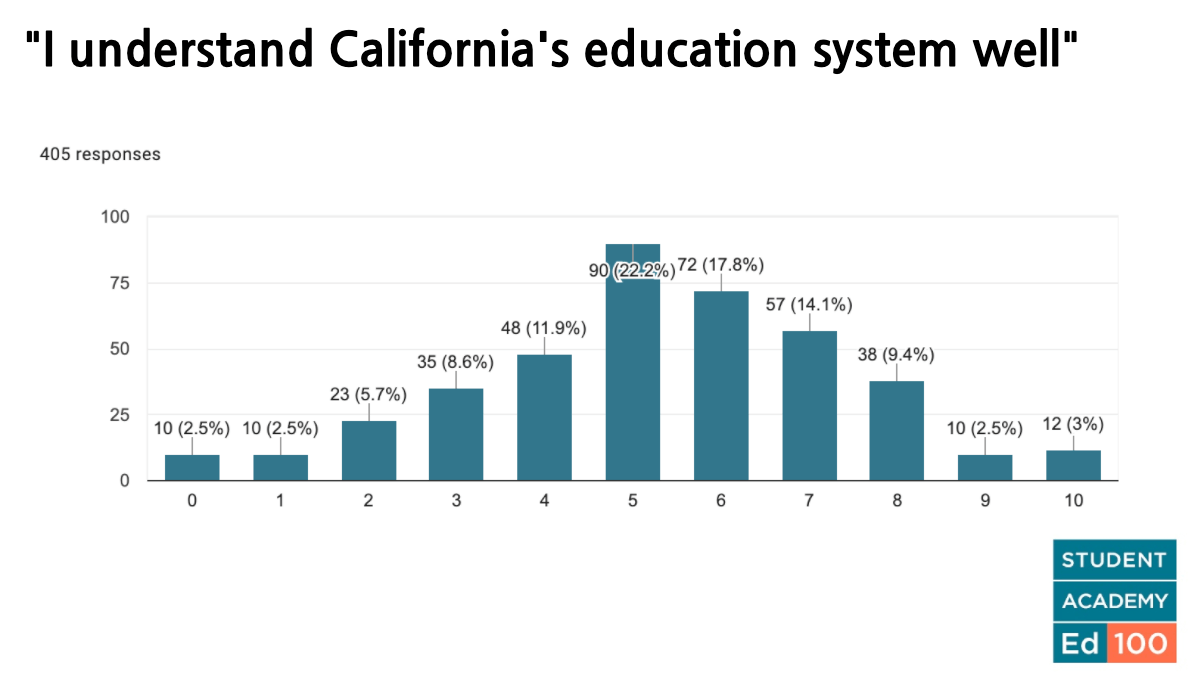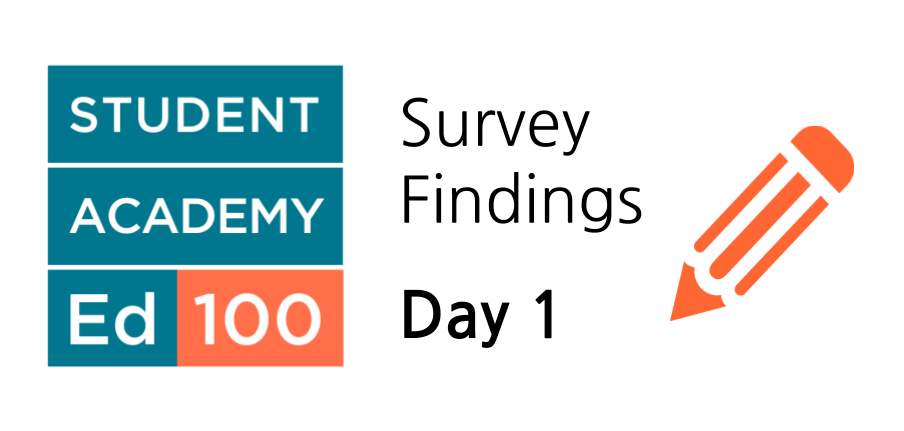The Academy Day 1: Education and Equity

Ready, Set, Go!
The Ed100 Student Academy, which was held July 20-23, 2020, attracted hundreds of student leaders from all over California. Our previous post in this series described the preparations. Over the next few weeks we will share what happened each day of the conference, including presentations, survey findings, and follow-up actions.
This post reviews the first day of the conference. The theme was education and equity.
|
|
10am - noon |
2pm - 4pm |
|---|---|---|
|
July 20 Monday |
① California's system |
② Equity in Education |
|
July 21 Tuesday |
③ Student Leadership |
④ Tools for Informed Leaders |
|
July 22 Wednesday |
⑤ Thinking Bigger |
⑥ Learning from History |
|
July 23 Thursday |
⑦ Working Together |
|
The Lead-up to the Conference
As we explained in the first post in this series, this conference was designed to help students understand how the education system works so that they can play leadership roles with confidence and credibility.

In order to help students navigate the conference and take effective notes, we created a Google document titled the Ed100 Academy Leadership Insights Journal. We encouraged students to make their own copy so that they could easily take notes and find links during the conference. We don't really know how many did so, but the link to the Journal was clicked 1,497 times, and some students mentioned it in feedback surveys as something we should do again.
Google docs can be used collaboratively, and some students elected to share their notes from the conference. (Read these notes for an example of what students found noteworthy!)
Nearly 1,000 of the student leaders who registered for the conference prepared for it by signing up for Ed100 and beginning the lessons ahead of time. By the end of the conference, 27 students had passed them all, earning their certificate as Ed100 graduates.
Students also prepared for the conference by downloading their personal Leadership Insights Journal (see sidebar).
Helping student leaders connect with one another was an explicit goal of the conference. More than 350 students joined a private Facebook Group exclusively for Ed100 Student Academy participants. Topics of discussion have included how students advocated successfully to add an ethnic studies course at their school, the value of a Future Farmers program, volunteer opportunities at the Oakland Zoo, a robotics club, several youth advisory councils, pet therapy, and more.
Helping student leaders connect with one another was an explicit goal of the conference.
To facilitate deeper connections, a few days before the conference started students were invited to join a "discussion group" with four other students from around the state. These groups were popular — about 450 students opted in — and also very simple: we just provided students with contact information and some discussion prompts to help get the conversation started. Results varied. Some groups led to friendships and connections. A few students listed their discussion group as a highlight of the conference.
Monday, July 20
The first day of the 3½ day conference aimed to bring all of the student leaders to a basic shared level of understanding about the education system, including key issues of equity. More than 500 students flooded into the Zoom waiting room at 9:45am.

Although 11th and 12th graders made up the majority of the conference, we saw very active participation among 9th and 10th graders, for example in the private Facebook Group.
This brief video, which we showed at the conference on Tuesday morning, can give you a feel for the day:
Brenna Pangelinan, Student Member, California State Board of Education
Brenna Pangelinan, the conference host, opened the day by challenging students to take this conference seriously, to use their Leadership Insights Journal, and to communicate with their discussion groups. The key takeaway from the day: by being informed, the student voice can be powerful.

The Leadership Insights Journal had 4 main prompts for each speaker:
(1) Things I learned from the speaker;
(2) How do I get involved?
(3) What do I do next?
(4) What else do I want to know?
Brenna was a masterful host. Her position as the student on the California State Board of Education is the highest position a high school student can have. Having an active student leader at the center of the conference was important for setting the tone that student leaders are valuable.
The conference flowed easily with her speaker introductions and fun polls. She began by sharing the results of two survey questions that more than 400 students had answered ahead of the conference:


Alex Bernadotte, Beyond12
“It is not an accident that education is inequitable. It is inequitable by design.”
— Alex Bernadotte
Alexandra Bernadotte, founder of Beyond12, shared her perspective as the first in her family to attend college. She underscored the role that race plays in students' access to education. "Systems achieve the outcomes they are designed to achieve. It is not an accident that education is inequitable. It is inequitable by design. We need more students as architects of this system."
Mary Perry, Independent Education Consultant
“Express your opinions, use your voice, but seek first to understand.” — Mary Perry
Mary Perry helped students dive into the specifics of how the education system in California works, with a particular emphasis on the role of money. She organized her presentation in four parts:
- What does it mean to be a public school in California?
- How are schools funded?
- How do schools spend the money they get and why?
- How should we measure schools' success?
In her remarks and in response to questions she gave her thoughts about the lasting damage that past economic downturns have inflicted on public education. "Express your opinions, use your voice, but seek first to understand," she advised. Students have power when their voice comes from an informed position. A student asked Mary to predict what would happen with regard to police officers on campus, and what would happen to teacher salaries. Mary explained that these are local decisions negotiated between school districts and unions. Students have little or no influence in those negotiations.
Michaela Weinstein and Ben Grieff, Evolve-CA
Michaela Weinstein, a recent graduate of Albany High School and member of that school district's board, joined Ben Grieff of Evolve-CA to explain the Schools and Communities First initiative, which will restore some funding for education if Proposition 15 passes in November.
The pair emphasized that lack of funding affects students. Without proper funds, students experience larger class sizes and scarce school mental health resources, which has an immense impact on students beyond a school day or school year. When students don’t receive the mental health resources or attention they need, the effects can continue into college and jobs beyond.
Anthony Chavez and colleagues, Education Trust-West

Each day of the conference we conducted a survey that included at least one major open-ended question: What are the three most important things you learned from today's sessions? If you want to get a feel for the robustness of the conference, read the responses.
Just One Change: What is one change you would like to make in your school or community? See responses
Three things I learned: What are the three most important things you learned from today's sessions? See responses
In the afternoon session, Anthony Chavez and colleagues from Education Trust-West delivered a content-rich presentation that began by exploring the difference between equality and equity in education. "Educational equity," Chavez said, "means that each child receives what they need to develop to their full academic and social potential, removing the predictability of success or failure that currently correlates with any social or cultural factor." He presented new findings from a survey by YouthTruth that set out to "measure what matters" including engagement, relationships, academic challenge, social-emotional learning, safety, and culture.
Manny Rodriguez gave students a rundown of how bills become laws in California, how the state's budget process works, the pressure points in the process where students can have influence, and eight policy priorities for equity. Mariah Cochran encouraged students to use Twitter as a way to build momentum for advocacy priorities and shared examples of how it can make a difference. Anthony closed the session by recommending that students consider using interactive "equity walks" to focus a community's attention on measurable issues that need attention and action.
Tony Thurmond, California Superintendent of Public Instruction
Tony Thurmond, California Superintendent of Public Instruction, joined the conference to thank students for leading. He expressed that his top priority was to keep people safe, and informed students of his intent to begin multiple initiatives: to implement implicit bias training in every school, to create a youth advisory council, and to hold a series about ethnic studies every Tuesday. He announced his current efforts to raise money from internet companies to close the “digital divide” in education throughout California.
"I know that the next Superintendent is out there… I'm just holding this seat for one of you.”
— Tony Thurmond
His closing remarks were impassioned: "I know that the next Superintendent is out there… I was raised on food stamps… My teachers told me life would be better if I just got this education, and they were so right! A lot of it just started with doing what you all are doing — being a student activist. All these places helped me find my voice. I was a shy, quiet kid, and no one in my family's ever, ever, ever run for office… I'm just holding this seat for one of you. Because my job is to support all of you. When you're ready, we got you. When you want to intern or something, we got your back."
Ted Lempert, Children Now
Ted Lempert of Children Now closed the day with a brief presentation about the Children's Movement, a coalition of organizations with a shared focus on advocacy for the overall interests of children, including education, health and more.
Access to Education Leaders
California’s education system is vast. In the ordinary course of a school year, students — even student leaders — are pretty distant from the leadership of the system that is meant to serve them. This conference reduced the distance.
Many esteemed education leaders joined the conference to share their knowledge with students and equip them with the tools they need to improve the education system they’re in. The first day of the conference created a space for student leaders to begin learning some of the inner-workings of the education system so that they can understand ways to engage in it.
California's more than six million students are the ultimate beneficiaries of this system, and also its primary workers. Learning only happens when students are doing the learning; no one can do it for them. Students feel the effects of education policy choices in ways that are personal and life-changing. Student leaders have a responsibility and a right to participate in leading an education system that addresses their needs. A student’s voice can carry power and moral force, especially when well-informed and connected. With knowledge and organization, students could be unstoppable changemakers and true education leaders.
More To Come!

That's a wrap for our recap of Day 1 of the Ed100 Academy for California Student Leaders. In two weeks, our next post in this series will describe what happened on Day 2, “Developing Informed Leaders”, in which students met a special guest and heard pitches from six remarkable organizations. Please mark your calendar now for next year's conference, and make sure other student leaders do the same!
|
Learn More About the 2020 Ed100 Academy for California Student Leaders |
|
|---|---|
|
Program Guide: |
|
|
Preview: |
|
|
Day 1: |
|
|
Day 2: |
|
|
Day 3: |
|
|
Day 4: |
|
 Kaylee Nguyen, an undergraduate student at UC Berkeley, serves as
Director of Admissions for the Ed100 Academy for High School Student Leaders.
Kaylee Nguyen, an undergraduate student at UC Berkeley, serves as
Director of Admissions for the Ed100 Academy for High School Student Leaders.Tags on this post
Policy Student voiceAll Tags
A-G requirements Absences Accountability Accreditation Achievement gap Administrators After school Algebra API Arts Assessment At-risk students Attendance Beacon links Bilingual education Bonds Brain Brown Act Budgets Bullying Burbank Business Career Carol Dweck Categorical funds Catholic schools Certification CHAMP Change Character Education Chart Charter schools Civics Class size CMOs Collective bargaining College Common core Community schools Contest Continuous Improvement Cost of education Counselors Creativity Crossword CSBA CTA Dashboard Data Dialogue District boundaries Districts Diversity Drawing DREAM Act Dyslexia EACH Early childhood Economic growth EdPrezi EdSource EdTech Education foundations Effort Election English learners Equity ESSA Ethnic studies Ethnic studies Evaluation rubric Expanded Learning Facilities Fake News Federal Federal policy Funding Gifted Graduation rates Grit Health Help Wanted History Home schools Homeless students Homework Hours of opportunity Humanities Independence Day Indignation Infrastructure Initiatives International Jargon Khan Academy Kindergarten LCAP LCFF Leaderboard Leadership Learning Litigation Lobbyists Local control Local funding Local governance Lottery Magnet schools Map Math Media Mental Health Mindfulness Mindset Myth Myths NAEP National comparisons NCLB Nutrition Pandemic Parcel taxes Parent Engagement Parent Leader Guide Parents peanut butter Pedagogy Pensions personalized Philanthropy PISA Planning Policy Politics population Poverty Preschool Prezi Private schools Prize Project-based learning Prop 13 Prop 98 Property taxes PTA Purpose of education puzzle Quality Race Rating Schools Reading Recruiting teachers Reform Religious education Religious schools Research Retaining teachers Rigor School board School choice School Climate School Closures Science Serrano vs Priest Sex Ed Site Map Sleep Social-emotional learning Song Special ed Spending SPSA Standards Strike STRS Student motivation Student voice Success Suicide Summer Superintendent Suspensions Talent Teacher pay Teacher shortage Teachers Technology Technology in education Template Test scores Tests Time in school Time on task Trump Undocumented Unions Universal education Vaccination Values Vaping Video Volunteering Volunteers Vote Vouchers Winners Year in ReviewSharing is caring!
Password Reset
Search all lesson and blog content here.
Login with Email
We will send your Login Link to your email
address. Click on the link and you will be
logged into Ed100. No more passwords to
remember!














Questions & Comments
To comment or reply, please sign in .
Vivian Chan August 13, 2020 at 7:06 pm